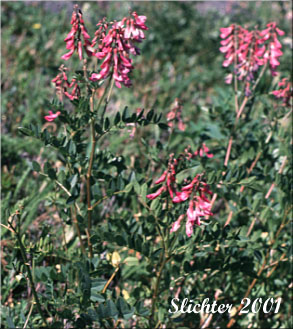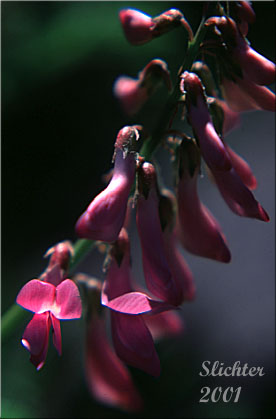

 Photo
at right illustrates western sweet-vetch from Silver Star Mt., Gifford Pinchot
N.F..........July 4, 1991.
Photo
at right illustrates western sweet-vetch from Silver Star Mt., Gifford Pinchot
N.F..........July 4, 1991.
Western sweet-vetch is an attractive plant with several branched stems rising 40-80 cm from a woody base. The leaves are pinnately compound with 9-21 leaflets, each 1-3 cm long. The leaflets are arranged opposite each other along the leaf with a single terminal leaflet.
The inflorescence is a raceme of 20-80 reddish to purplish flowers which often hang to one side of the stem. Individual flowers are 15-22 mm long with a short, tubular calyx from 4-5 mm long. The seed pods have 1-4 ovate-elliptic segments, each about 7-12 mm wide. The pods are often eaten by rodents while the roots are nourishing and taste somewhat of licorice.
Other common names include western heysarum and western sweet-broom.
Western sweet-vetch is found on dry, well-drained rocky soils at higher elevations in the mountains.
Western sweet-vetch may be found from western Montana and Idaho south through the Rocky Mts. to Wyoming and Colorado. To the west it is found in the Olympic Mts. and occasionally in the Cascade Mts.
In the Columbia River Gorge, it may be found only on several taller peaks surrounding Silver Star Mt. at the southwestern edge of the Washington Cascades.